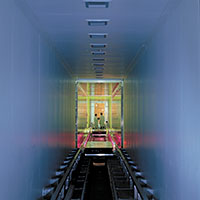Background
Traditionally, ethylene oxide sterilization processes are routinely monitored with biological indicators that are composed of the microorganism Bacillus atrophaeus, usually inoculated onto a 1.5 X 0.25 inch paper carrier. A good example of a biological indicator is the Spordex® (STERIS) bacterial test strip.
For routine monitoring purposes, the biological indicators are placed throughout the sterilizer load and subjected to the sterilization process. After the process, the biological indicators are removed from the load and forwarded to the testing laboratory, where they are placed into a special growth medium and subjected to ideal growth conditions for 7 days (as addressed in USP1). After the 7-day incubation period, negative growth of the biological indicators demonstrates that the sterilization process was effective. The sterilizer load may then be considered for release to market, provided all other release criteria are met.
When using this traditional biological indicator monitoring of the EO sterilization process, expenses are incurred in two ways. First, there is the expense of the biological indicators and the associated laboratory testing; and secondly, there is a large amount of capital tied up in the inventory which must be held “in quarantine” until after the laboratory testing is complete (7 days).
In addition to the expense, the use of biological indicators will increase risks due to the possibility of contamination of the indicator while being handled at the testing laboratory. In most cases, a failure of a biological indicator, even though laboratory induced, would be considered a sterility failure and result in the requirement for reprocessing of all of the materials which were contained in the sterilizer load. This increases costs to both the monitoring system and held inventory.
An Alternative Monitoring Method
ANSI/AAMI/ISO 11135 defines parametric release as the “declaration that product is sterile, based on records demonstrating that the process parameters were delivered within specified tolerances”. In short, parametric release allows product to be released to the market based on process records instead of the traditional biological indicator sterility test. This is advantageous in that it eliminates the routine costs associated with biological indicators and laboratory testing. Also, there may be additional savings associated with a reduced hold time of unreleased inventory when using parametric release.
Overview – Physical Requirements
Multiple physical parameters must be analyzed during the validation process in order to establish the tolerances for parametric release on a routine basis. The following list taken from section 10.2 of ANSI/AAMI/ISO 11135 details the physical elements to be considered:
Preconditioning Phase
- The minimum temperature of the product entering the sterilization process and/or the defined conditions used to acclimate the load
- Temperature and humidity within the preconditioning area (if used), monitored and recorded from a specified position
- Time of commencement of preconditioning and of removal of load from preconditioning (if used) of each sterilization load
- Elapsed time between removal of the sterilization load from preconditioning (if used) and the commencement of the sterilization cycle
Sterilization Phase
- Chamber humidity during conditioning and/or humidity dwell phases by pressure, pressure rise (ΔP) and/or direct monitoring
- Conditioning time
- Indication of the satisfactory operation of the chamber gas circulation system (if used) during EO injection and during exposure
- Temperature and pressure in the chamber throughout the sterilization cycle
- If pressure is used as the primary control measure, the requirement for the secondary measure is only to confirm admission of EO to the chamber by at least one of the following: the mass of EO used; the direct measurement of the concentration of EO in the sterilization chamber; volume of EO used
- EO injection time
- Inert gas injection (if used)
- Exposure time
- Time taken to evacuate the chamber
- Time and pressure changes during post exposure flushing
Aeration Phase
- Time, temperature pressure changes (if any) during aeration
In addition, the following physical parameters must be included as part of the parametric release criteria as directed in section 10.5 of the ANSI/AAMI/ISO 11135 document:
- Temperature in the chamber from a minimum of two locations throughout the sterilization cycle
- Chamber humidity during conditioning as determined by direct measurement
- The EO concentration, determined from direct analysis of chamber atmosphere using analytical methods at defined intervals sufficient to verify the required conditions throughout the exposure time.
Special Considerations for Parametric Release
When designing a parametric release program, special consideration is given to outside factors that can impact the delivery of the sterilization process. Factors to take into consideration include:
Simulation of Winter Conditions
To assure that preconditioning (if used) and/or conditioning is effective regardless of climatic conditions or facility location, each half cycle validation load is exposed to simulated winter conditions prior to half cycle processing. Successful biological results when challenged with this worst case load conditioning assures that the process is effective for all conditions regardless of the time of the year or the location of the facility.
Load Configuration
Control of loading patterns and densities is required when practicing parametric release. For those customers that present mixed loads to the sterilizing facility, a fourth half cycle is required using the minimum loading configuration at minimum density. This load is processed in a biological challenged half cycle using minimum cycle conditions. Successful biological results using this minimum loading condition when supported by the successful maximum loading half cycles, serves to validate the process for any load mix from the minimum loading qualified to the maximum loading qualified.
References
- United States Pharmacopeia, 37th edition, 2014.
- ANSI/AAMI/ISO 11135, Medical devices – Validation and routine control of ethylene oxide sterilization, 2014.
View our complete library of technical information on gamma irradiation and ethylene oxide sterilization.




